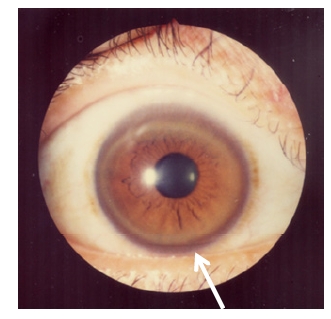Playlist
Show Playlist
Hide Playlist
Wilson's Disease (Hepatolenticular Degeneration)
-
Slides 09 Movement Disorders Neuropathology II.pdf
-
Reference List Pathology.pdf
-
Download Lecture Overview
00:01 Here, we have Wilson’s disease. 00:03 And Wilson’s disease, it is an autosomal recessive disease in which there is going to be a defect in copper transportation. 00:12 So think about copper, please. 00:14 And how it’s extremely, extremely, important for us to have it so that we have proper metabolism or should I say, proper creation and synthesis of collagen. 00:25 And so you all have heard of what’s known as oxidase, lysyl oxidase. 00:31 So, in biochemistry, when you talked about collagen synthesis, you talked about two major enzymes, one requiring vitamin C and that was hydroxylase, lysyl and prolyl. 00:41 The other major enzyme that was responsible for some of the triple helix movement or should I say stabilization of the collagen or was because of the copper. 00:51 Results in excessive serum copper. 00:53 What do you mean by excessive serum copper? Well, it’s the fact that you might have excess free copper that’s floating around. 01:02 Well, how can you call this a copper disease and yet, you have excess free copper? Because I said specifically, it’s a copper transportation disease. 01:11 So remember the – We talked about this earlier, the transporter from the liver for copper is called ceruloplasmin. 01:18 And that’s where the problem is. 01:20 If you have a deficiency of ceruloplasmin, then you decrease the bound, but the free is allowed to run free. 01:28 And where all does the free copper then accumulate? It can accumulate in the basal ganglia, and when it does, it may result in, well, Parkinson-like type of movement disorder. 01:39 The free copper could accumulate in the iris. 01:41 We then call this Kayser-Fleischer. 01:43 And the free copper of course could accumulate in the heart and in the liver causing respective diseases. 01:49 The copper deposition into liver, kidney, cornea, in CNS, and particularly in the basal ganglia, our topic here, ladies and gentlemen, being what? Movement disorder. 02:01 So with Wilson’s, what are your clinical features? Well, if you’re affecting the basal ganglia, obviously, you’re going to expect Parkinson type of movement disorder, tremors, hyperkinetic movement, parkinsonism, dysarthria, cognitive, personality and mood disturbance because this free copper, man, it is damaging the brain anywhere and everywhere. 02:23 If you take a look at the iris in this individual with Wilson’s disease, you’ll notice the areas in the iris in which they then appear as being destroyed or lesioned. 02:33 This is then referring to what’s known as Kayser-Fleischer ring. 02:38 A golden brown or greenish discoloration of the limbus of the cornea and due to copper deposition, obviously free copper. 02:47 If you were to then check for serum or labs, you would expect there to be increased or elevated free serum copper, and what did I say, where did you want to begin with this disease? It’s the fact that it’s a transportation disease. 03:00 Thus, decreased ceruloplasmin. 03:06 Elevated 24-hour urine copper as you can imagine, and that being the most important test for screening and diagnosis of course would be by biopsy to confirm your disease or diagnosis of Wilson’s disease. 03:20 Management: Chelation. 03:22 Penicillamine. 03:24 And we have something called trientine with zinc. 03:28 Now, with penicillamine, interesting issue. 03:31 With penicillamine, it may then actually cause damage to the kidney. 03:36 There’s every possibility that over a long period of time with penicillamine, it may result in something called your membranous glomerulonephropathy and we talked about that earlier. 03:47 Keep that in mind, please. 03:48 Kidney disease with penicillamine. 03:53 Important note: Always think about Wilson’s disease in a young patient with a movement disorder or atypical type of psychiatric presentation. 04:00 That’s something that you want to keep in mind.
About the Lecture
The lecture Wilson's Disease (Hepatolenticular Degeneration) by Carlo Raj, MD is from the course Movement Disorders.
Included Quiz Questions
A 25-year-old man presents to your clinic with rigidity, tremors, and a loss of balance for the last four weeks. He is brought by his wife, who states that he has been acting strangely for the past several days. He gets upset and angry frequently. On examination, a golden-brown discoloration is found in the periphery of each iris. What is the pattern of inheritance in this condition?
- Autosomal recessive
- Autosomal dominant
- Sex-linked recessive
- X-linked dominant
- X-linked recessive
A 20-year-old man presents to your clinic complaining of loss of balance for the past two weeks. He recently experienced a fall, in addition to mood and behavioral changes. A physical examination reveals tremors in his extremities and a rusty brown discoloration around the peripheral cornea, just inside the limbus, in each eye. What is the next step in the evaluation?
- 24-hour urine copper
- Liver biopsy
- Serum ceruloplasmin
- 24-hour serum copper
- CT head
A 28-year-old woman presents to her physician's office for evaluation of behavioral changes. She has been acting strangely and was referred by her employer for a checkup. After the history, physical exam, and lab evaluation, Wilson disease is diagnosed. Which of the following represents the pathology and the typical sites of the lesions?
- Elevated copper, basal ganglia, liver, eyes
- Elevated copper, frontal lobes skin
- Decreased copper, basal ganglia, muscle
- Elevated copper, cerebellum
- Decreased copper, cerebrum, kidneys
Customer reviews
5,0 of 5 stars
| 5 Stars |
|
1 |
| 4 Stars |
|
0 |
| 3 Stars |
|
0 |
| 2 Stars |
|
0 |
| 1 Star |
|
0 |
excellent teacher with effiecient teaching methods. Lecturio is very helpful generally




